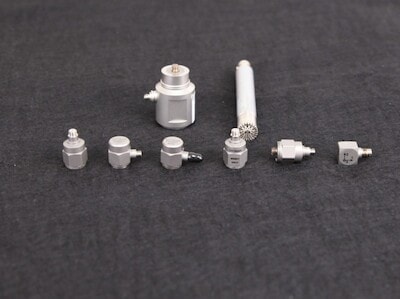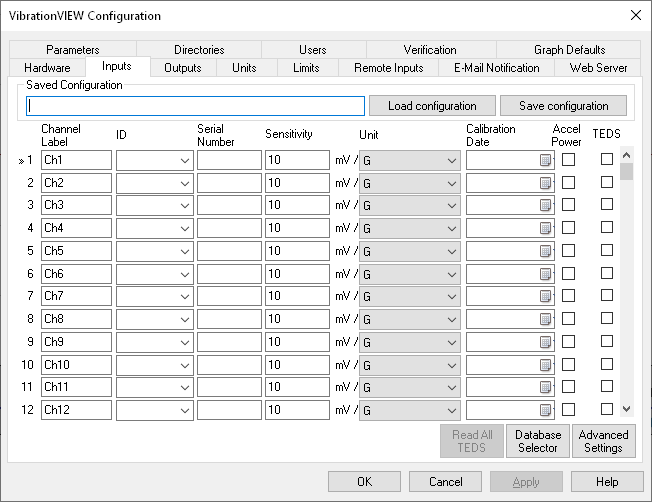Article Overview
- Overview of three primary accelerometer types
- Piezoelectric (PE)
- Piezoresistive (PR)
- Capacitive
- Sensitivity considerations
- High-temperature applications
- Introduction to integrated electronics (IEPE) and transducer electronic data sheets (TEDS)
The accelerometer is the most common type of transducer used in the vibration industry. One or more are attached to a device under test and relay the output signal to the vibration controller. Accelerometers are available in many competing models with varied specifications. Below, we discuss three popular accelerometer types and discuss piezoelectric (PE) accelerometers—the most popular option—more in-depth.
Types of Accelerometers
 A piezoelectric (PE) accelerometer is most frequently used in vibration testing. In the PE accelerometer, a mass pushes against a crystal which results in an accumulation of electric charge. A PE accelerometer is used for high temperature and high-frequency situations and can be set up with basic mounting techniques.
A piezoelectric (PE) accelerometer is most frequently used in vibration testing. In the PE accelerometer, a mass pushes against a crystal which results in an accumulation of electric charge. A PE accelerometer is used for high temperature and high-frequency situations and can be set up with basic mounting techniques.
A piezoresistive (PR) accelerometer is useful when sudden or extreme vibration is anticipated. A mass within the accelerometer is attached to a variable resistor. When the mass moves, the resistance changes; consequently, the current changes as well.
A capacitive accelerometer is used for low-frequency applications. In the capacitive accelerometer, a mass is attached to one plate of a capacitor. The movement of the plate changes the capacitance of the capacitor.
When to Use a Piezoelectric (PE) Accelerometer
PE accelerometers are superior in high frequency (<3 Hz to 30 kHz) and high-temperature (260 oC) situations. As many vibration tests require high-frequency testing, a PE accelerometer is often recommended.
PE accelerometers are well suited for vibration and shock testing. They are available in a range of sensitivities and a variety of sizes and weights.
Why is Sensitivity Important?
The sensitivity of an accelerometer largely determines the range of acceleration that the device can read. A 100 mV/G accelerometer is typically limited to 50 G measurements, meaning measurements around 50 G will be inaccurate and subject to clipping.
A 10 mV/G accelerometer will have lower voltage outputs. For very low signals, the measurement may be lost in the noise floor of the controller’s input. When using a quality controller with a low input noise floor, 10 mV/G will provide satisfactory results from very low signals out to around 500 G.
Accelerometer sensitivity is important to consider as structures often have high resonances measuring over 50 G.
When to use a High-Temperature PE
Accelerometers perform well under certain ranges of temperature. PR accelerometers operate well at normal ambient temperatures. Integrated electronic piezoelectric (IEPE) accelerometers can be used to a maximum temperature of about 175 oC. Regular PE accelerometers can be used to approximately 260 oC and high-temperature PE accelerometers work up to 650 oC.
When test conditions will exceed 250 oC, such as during a thermal cycling environmental stress screening (ESS) test, it would be advisable to use a high-temperature PE accelerometer.
Why use an IEPE Piezoelectric Accelerometer?
An IEPE is a piezoelectric accelerometer that contains additional electronics to boost the output signal. Much of the noise that affects the signal occurs in the cabling. Boosting the signal after the cabling is a great advantage to minimize the effects of noise.
Why Support TEDS?
Many accelerometers are equipped with TEDS (transducer electronic data sheets). Embedded in the memory of an IEPE accelerometer is the calibration data and characteristics of the accelerometer such as its calibrated sensitivity, calibration date, serial number, manufacturer, and calibrated frequency range.
TEDS is an efficient method of maintaining a record of important information about the accelerometer. Rather than making paper copies of the accelerometer sensitivity and calibration data for each technician, all the pertinent information is stored electronically on the PE. This also allows the controller to verify and read calibration data directly from the accelerometer, which prevents transcription, cabling, and data entry errors. TEDS is a helpful and worthwhile tool for test engineers.
Accelerometer Selection
Selecting the appropriate accelerometer requires the engineer to consider measurement range, frequency response, temperature tolerance, and noise immunity. Piezoelectric accelerometers are preferred for high-frequency and high-temperature applications, while piezoresistive types are suited for extreme vibrations. Capacitive accelerometers excel in low-frequency scenarios. Understanding these characteristics helps to ensure accurate and reliable vibration testing results.

